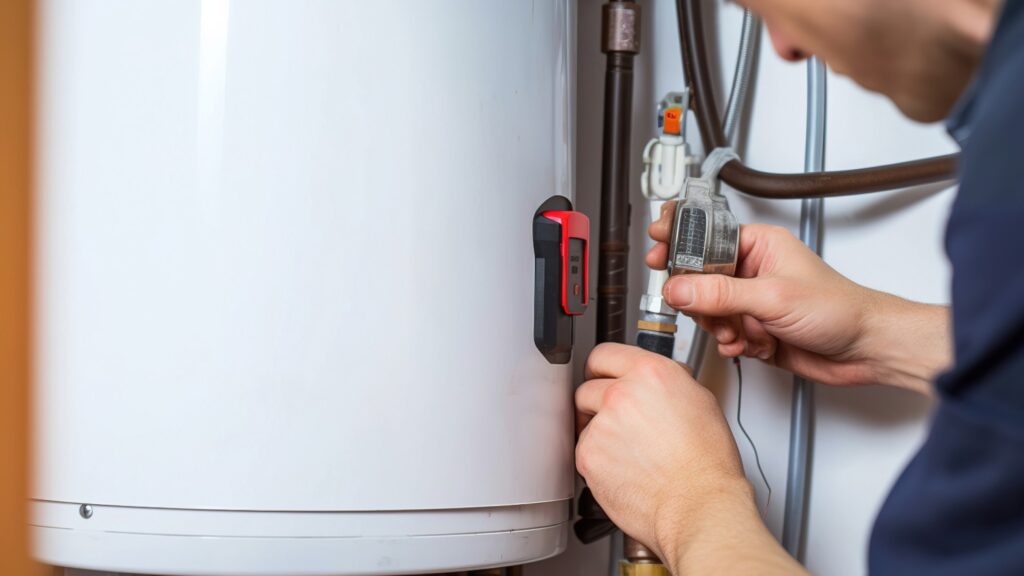We all want to have hot water on hand when we need it, whether we’re washing dishes or unwinding in a steamy shower setting. When it’s time to consider a new hot water heater for your Bowling Green area home, Tin Man Heating & Cooling is here to explain the difference between tank and tankless water heaters.
For many homeowners, the choice boils down to two primary contenders: the familiar, traditional tank water heater and the sleek, modern tankless (or on-demand) system. Which one truly reigns supreme? Let’s dive in and explore the ins and outs of each to help you make the best decision for your home and budget.
Understanding Tank Water Heaters
Most of us are familiar with the trusty tank water heaters that sit ready with a load of hot water in a well-insulated tank. These water heaters draw cold water from your home’s water supply, directing the water to the bottom of the tank where it can get warmed up. A heating element – a gas burner if you’re heating water with gas, and an electrical element if you rely on electricity – heats the water and causes it to rise to the top of the tank. When you turn on the faucet, the hot water is pushed out from the top and sent to your tub, dishwasher or other hot-water appliance.
Tank water heaters include a thermostat that keeps the water at an optimal temperature, and the insulated tank helps minimize heat loss when you’re not using the water. Like any piece of equipment, tank water heaters have their benefits and drawbacks:
Pros:
- Lower upfront cost: Tank water heaters are generally less expensive to purchase and install.
- Simpler installation: Replacing one tank system with another is usually a simple, straightforward job.
- Reliable hot water supply (for their capacity): Tank water heaters are good for consistent, predictable hot water usage, as long as you’re not draining the hot water supply with your demand.
- Variety of fuel types: These trusty models are available in electric, natural gas, propane, and even some solar options.
Cons:
- Limited hot water supply: Tank water heaters may not be able to keep up with the demand for hot water, especially during peak usage.
- Higher energy consumption: Tank water heaters are continuously heating water, even when they’re not in use.
- Takes up space: Bulky tanks require a dedicated area.
- Shorter lifespan: Expect to get about a decade out of your tank water heater.
- Maintenance: Tank units require annual flushing to prevent sediment buildup.
- Risk of leaks: Older tanks can corrode and leak.
Understanding Tankless Water Heaters
Tankless water heaters are also known as on-demand or instantaneous water heaters because they’re not sitting around waiting with a tank full of hot water on the ready. Like their tank counterpart, they start by drawing cold water through your home’s plumbing system. But this water is immediately heated via a heat exchanger made from copper or stainless steel. The heated water is quickly delivered to your faucet or appliance. Once the tankless water heater’s flow sensor no longer detects water movement, it shuts off the heating process.
We’re big fans of tankless water heaters here at Tin Man Heating & Cooling, and we foresee tankless eventually becoming the water heater of choice. But homeowners are encouraged to consider the strengths and drawbacks of the tankless models:
Pros:
- Endless hot water: Most models provide a continuous supply of hot water. Yay for no more unwelcome cold showers!
- Energy efficient: Because tankless water heaters only heat water when it’s needed, you’re not spending energy to heat water that’s going to be sitting in a tank for a while. According to the S. Department of Energy, tankless water heaters can be 24%-34% more energy efficient in homes that use 41 gallons or less of hot water daily. Even if you’re using twice that, the tankless water heaters can be 8%-14% more energy efficient.
- Space-saving design: Tankless water heaters are compact and can be wall-mounted.
- Longer lifespan: With proper maintenance, you can be in hot water for 15-20 years.
- Cleaner water: No stored water means no rust or sediment buildup in the tank.
Cons:
- Higher upfront cost: Tankless water heaters are going to cost more upfront to purchase and install.
- Complex installation: Some homeowners may require upgrades to gas lines or electrical systems, increasing installation costs.
- Flow rate limitations: If you’re a household where multiple showers are running at the same time – or you’re trying to hop in the shower while also doing a load of laundry – you may notice a weaker flow rate.
- Hard water sensitivity: Northwest Ohio’s hard water means you’re going to want to schedule regular descaling.
- Electrical dependency: Most tankless units (even gas) require electricity to operate. So, if there’s a power outage, you’re taking a cold shower (or waiting for the lights to come back on.)
Which water heater is right for you?
If you’re in the market for a new hot water heater, Tin Man can walk you through this important decision. We’ll talk about upfront cost vs. long-term savings, so you can make an informed decision about the overall affordability. We’ll ask how many people will be using hot water in the home, and whether you have the space for a water heater tank. Finally, we’ll talk to you about important maintenance investment. The best way to keep the hot water flowing is to schedule annual water heater maintenance with a trusted partner like Tin Man.
Make sure the hot water keeps flowing in your home. If your hot water heater is pushing double digits, or you’re paying for frequent repairs, it may be time to invest in a shiny new model. Reach out to Tin Man today at 419-353-4448 or request an appointment online. Your steamy shower awaits!

